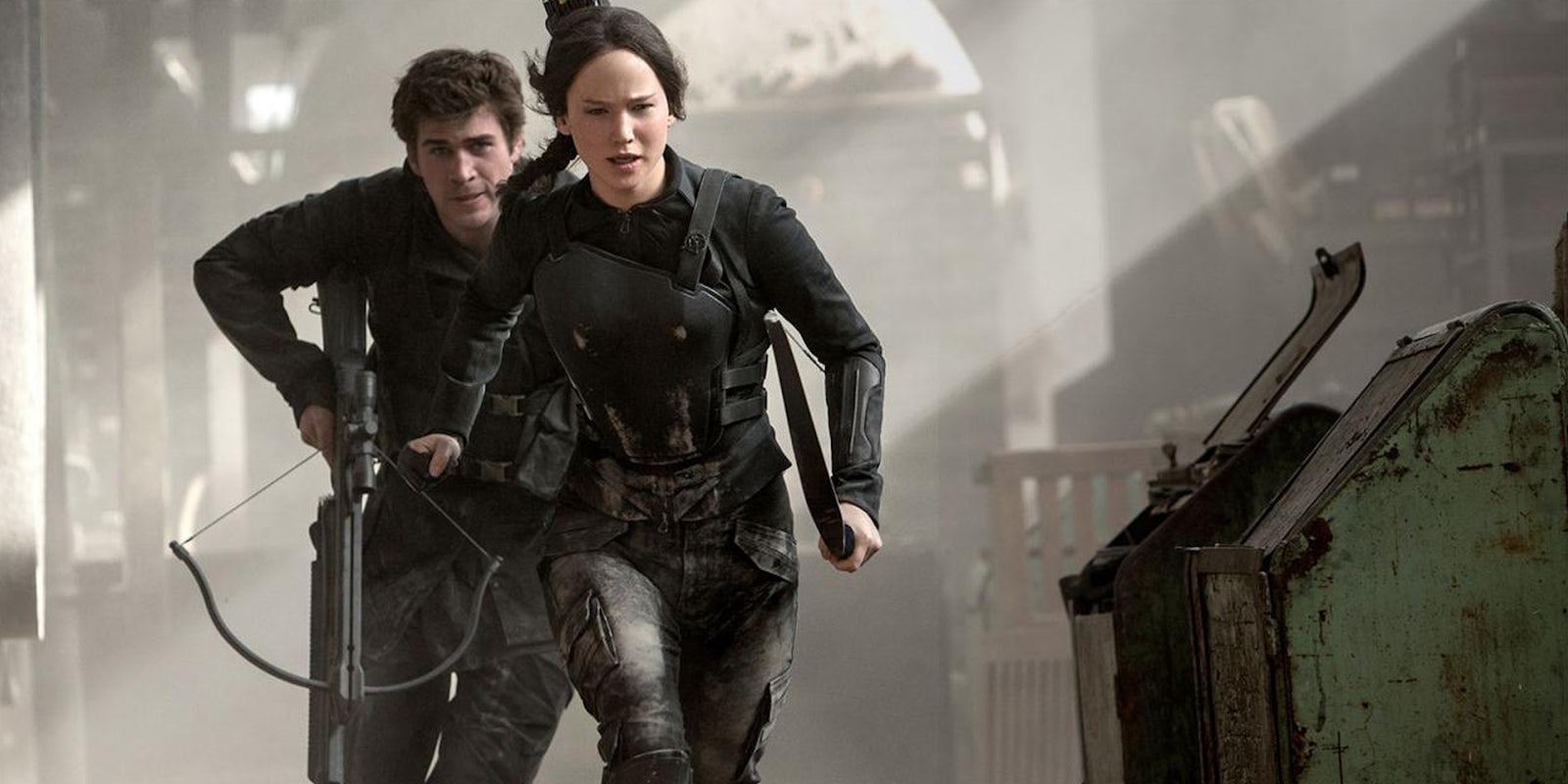Hunger Games: Mockingjay Part 1 is an unusual combination of action thriller and bootcamp in media criticism.
Like Harry Potter and Twilight, the final volume of the Hunger Games has been split into two movies. In the case of Harry Potter and the Deathly Hallows this resulted in two of the best films in the series, but Mockingjay may prove a little more divisive. Depending on who you’re asking, the decision to make four movies is either a blatant cash-grab, or a smart way of restructuring the weakest book of the trilogy.
Mockingjay is the only installment to contain no actual Hunger Games, so it doesn’t lend itself so well to the action-adventure structure of the first two movies. Instead, Mockingjay Part 1 focuses more on deepening our understanding of the Hunger Games universe, from Katniss Everdeen’s deteriorating emotional state to one of the main themes of the series: the intersection of propaganda and celebrity.
By this point Katniss is suffering from PTSD and has seen her hometown reduced to rubble, the few survivors fleeing to the secretive bunker of District 13. While the first two movies were essentially survival stories, her physical safety is now in less danger than her mental health.
Rather than being able to fight back with a bow and arrow, Katniss is forced to realize that she can do more as a figurehead of the revolution—a job that requires her to be filmed visiting field hospitals full of corpses, and to sit around in a bomb-proof basement while normal citizens are torn up by the Capitol’s machine guns. It’s a role that subverts the traditional One True Savior idea behind many young adult fantasy franchises. Katniss’s job isn’t to defeat an enemy in single combat, but to be another cog in the machine of the dirty, bloody revolution that will supposedly free her people. Coached by a team of PR experts in an obvious reversal of her time as a Hunger Games tribute, her task is to present a veneer of heroism for the cameras.
The first two movies are unambiguous in their criticism of the image-obsessed Capitol. In order to survive the Hunger Games, the ability to manipulate one’s own media narrative is almost as important as the ability to fight. But while Katniss consistently fails to perform on cue, her authenticity is what inspires people to follow her as an icon of the revolution.
This is one of the many little details where art mirrors life in the Hunger Games series, in this case relating to the Jennifer Lawrence’s celebrity status. Lawrence became a pop-culture darling by seeming approachable and “real,” but wound up having her privacy violated by strangers. After avoiding the public eye for months, her recent media appearances have mostly been a result of her contractual obligations to promote this very movie. The Hunger Games franchise is a parable about the dark side of slick, big-budget advertising, but it relies on that very thing to make its money.
The online marketing for this installment purposefully aped the Capitol’s own dystopian propaganda campaigns. Instead of just telling us more about the Hunger Games universe like in a typical viral marketing campaign, we got sites like Capitol Couture (the in-universe Hunger Games lifestyle magazine) and its eerily realistic double-speak about preserving the unity of Panem.
These ads work in the traditional sense as movie trailers, but they’re simultaneously trying to get fans more invested by breaking a cardinal rule of advertising: Don’t allow the audience to think critically. But since propaganda, advertising, and political spin are at the core of Mockingjay Part 1, these broadcasts from Peeta and President Snow actually enrich the experience of watching the film. It gives us a sense of continuity between Catching Fire and the new movie, and reminds us of the Capitol’s power as a media empire.
Mockingjay strays pretty far from the blockbuster action archetype of good guys (even morally ambiguous, traumatized good guys) working their way past various setbacks to defeat a villain in the final act. Yes, Katniss is the face of a rebellion, but she’s restricted from actually leading anyone into battle. Instead we get the more complex emotional conflict of realizing that she can do more good in front of a TV camera, if indeed she can do any good at all. It’s the narrative equivalent of Bruce Wayne realizing that the whole Batman thing was kind of self-indulgent, and maybe he should’ve just used his social status to raise money for charity instead.
Most years there are one or two movies that are labeled as cerebral blockbusters, the kind of big-budget Hollywood fare that includes lots of action scenes but can be viewed with an aura of snobbish respectability. This year’s was undoubtedly Interstellar, but it’s a pity that Mockingjay Part 1 won’t be viewed in a similar light.
By framing itself as a teen movie franchise with an A-list cast, the Hunger Games quadrilogy has effectively tricked mainstream audiences into watching a series of movies about income inequality, PTSD, and teenagers being judged and manipulated by their elders. You couldn’t really describe it as a fun, uplifting way to spend your evening, but more than either of its predecessors, Mockingjay Part 1 makes it clear why the Hunger Games continues to strike a nerve.
Photo via fansided
